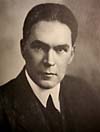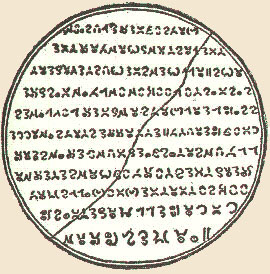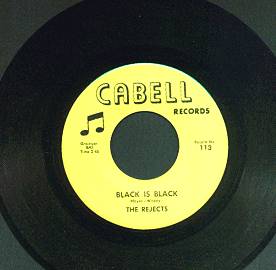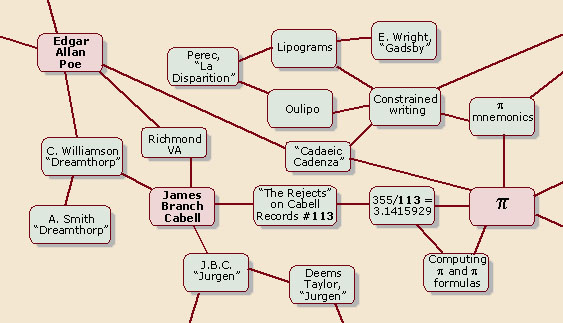 |
James Branch Cabell
Overview and Personal
Notes |
Welcome to one of the few pages on the Web devoted to James Branch Cabell. (The other one you should not fail to check out is at the J.B.C. Library at Virginia Commonwealth University in Richmond.)

Who, you may ask, is James Branch Cabell? Ah, where to begin? James Branch Cabell (1879-1958) of Richmond, Virginia wrote about 50 books between 1905 and 1955, including the only octodecalogy that I'm aware of in literature - that's an 18-volume work - called the Biography of The Life of Manuel. (Actually, although the Biography was published in 18 volumes of the Storsende Edition, true Cabell fans know that by proper counting it is really 20 volumes, thus following the "fixed law of Poictesme that all things must go by tens forever".)
Cabell's rise to fame began with the volume of the Biography called Jurgen, a highly entertaining novel about the eponymous pawnbroker involving elements of fantasy, mythology, adventure, satire, and commentary on human nature. In the early 1920's, after Jurgen was banned for a short time in the U.S. on obscenity charges, and after Cabell followed it up with two other volumes of the Biography that are essentially prequels (Figures of Earth and The Silver Stallion), he became nearly a household word and moved in the same literary circles as Sinclair Lewis, H.L. Mencken, and F. Scott Fitzgerald, to name a few. By the 1930's, Cabell's star was on the wane, and not long after he had sunk into obscurity. Cabell may win the award for the most obscure writer (today) who at one time was hugely famous.
Quite a few of Cabell's books are still in print, but some of the more obscure one take some effort to find. It's easy to find a copy of Jurgen (for example, the inexpensive Dover paperback), which is as good a place as any to begin reading Cabell. Other titles I would highly recommend (besides the Jurgen "trilogy") are: Straws and Prayer Books, These Restless Heads, Something About Eve, the Smirt/Smith/Smire trilogy, and his novel of contemporary Virginia life that has one of my favorite titles of all time: The Rivet in Grandfather's Neck.
Cabell uses a fair amount of word play in his writings: anagrams, puns, and various poetic devices. This is one excuse for this page's existence; the other is to let the world know that yes, there are still some of us Cabell fans out there. And, as you will see, I am a permanent one.
Wordplay in the Works of J.B.C.
It is James Branch Cabell's use of word play in his writings that most qualifies him for presence in these pages. Few writers of his stature have used the anagram as extensively to hide additional messages in his prose for discovery by the diligent reader. In Jurgen the hero encounters a tribe who worships the triune godhead of Ageus, Sesphra, and Vel-Tyno, which are obvious anagrams. (Go ahead, figure 'em out. Then read the book, and you'll really understand.)
Cabell's use of anagrams has an interesting side effect - sometimes he invents names that look like they ought to be anagrams but really are not. So part of the puzzle is just in figuring out which ones really are anagrams and which ones you just think are. (There's a subtle point here about extracting the meaning the artist intended versus infusing a work of art with your own meaning.) For example, two important place names in the Biography are Poictesme, a fictional province in France, and Storisende, the name of a castle in Poictesme. Both of these really look like anagrams, but they are not. Poictesme is a portmanteau word formed from two real place names, and Storisende is a pun on "story's end".
In Something About Eve, the hero, Gerald Musgrave, travels through six different lands named Doonham, Dersam, Lytreia, Turoine, Mages, and Mispec Moor. All of these are anagrams whose solution greatly enhances the meaning of the story.
Finally, we mention another unique device of Cabell, the "prose poem". In several of his books, especially Figures of Earth and Jurgen, he hid a number of poems within the novels' prose. Here is an simple example, from page 97 of the Kalki edition if Jurgen:
"Lo, for I pray to thee, resistless Love," he descanted, "that thou today make cry unto my love, to Phyllida, whom I, poor Logreus, love so tenderly, not to deny me love! Asked why, say thou my drink and food is love, in days wherein I think and brood on love, and truly find naught good in aught save love, since Phyllida hath taught me how to love."
Here Jurgen groaned with nicely modulated ardor; and he continued: "If she avow such constant hate of love as would ignore my great and constant love, plead thou no more! With listless lore of love woo Death resistlessly, resistless Love, in place of her that saith such scorn of love as lends to Death the lure and grace I love."
This is a fourteen-line poem whose structure is easy to discover given the fact that each line of the poem ends with the same word.
On the Permanence of J.B.C. Fandom
Besides having a fairly complete collection of James Branch Cabell first editions, and besides having read nearly everything ever written by or about J.B.C., I have one more feature by which I lay claim to being one of the foremost Cabell fans. This permanent feature was inscribed on my upper left arm in December 1995 in Portland, OR:

My James Branch Cabell tattoo, and Frank C. Pape's
cover illustration from the large-paper edition of Cabell's
The Silver Stallion, on which it is
based.
Yes, it hurt, but it was worth it. I'm often tempted to add Dom Manuel's slogan Mundus Vult Decipi ("the world wishes to be deceived") to the design as in the original. Especially since the phrase is even more true today than when Cabell invented it in the 1920's. 'Nuff said.
A Cabell Sampler
James Branch Cabell's self-prolaimed goal in life was to "write perfectly of beautiful happenings". Here is a tiny sampler of J.B.C's writings, beginning with his single most famous passage, and continuing with a few excerpts from his other books.
"Each to his creed," said Yaotl. "So do men choose between hope and despair."
"Yes, creeds mean very little," Coth answered the dark god, still speaking almost gently. "The optimist proclaims that we live in the best of all possible worlds; and the pessimist fears this is true. So I elect for neither label. I merely know that, at the end of all my journeying, there remains for me only to settle down, in my comfortable castles yonder in Poictesme, and to live contentedly with my fine-looking wife Azra and with my son Jurgen.".
-- The Silver Stallion, Chap. 26For some occult reason ideas become far more revolting when they are very.
These Restless Heads, Chap. 35After dark, Antan always displayed eight lights, six of them grouped together in the middle of the vista with the general effect of a cross, and the other two showing much farther off to the northwest. About those never-varying lights Gerald had formed at least twenty delightful theories, all plausible as long as you remained upon Mispec Moor, whereas if you went to Antan not more at most than one of these theories could prove true.
To go to Antan thus meant the destruction of no less than nineteen rather beautiful ideas as to those lights alone.
--Something About Eve, Chap. 37.For, as you of course perceive, the literary artist plays: he does nothing else, except with haste and grudgingly; and the sole end of his endeavor is to divert himself.
--Straws and Prayer BooksIt is my foible, one among a great many, to be a devotee of the niceties, of the overtones, and of the precisions of very often rewritten and suitably colored prose.
--Special Delivery"I bleach. In time I shall bleach that garment you are wearing. For I take the colour out of all things. Thus you see these stuffs here, as they are now. Clotho spun the glowing threads, and Lachesis wove them, as you observe, in curious patterns, very marvellous to see: but when I am done with these stuffs there will be no more colour or beauty or strangeness anywhere apparent than in so many dish-cloths."....
....For mine are all the sapphires and turquoises and whatever else is this dusty world is blue; and mine likewise are all the Wednesdays that have ever been or ever will be: and any one of these will I freely give you in return for your fine speeches and your tender heart."
--Sereda to Jurgen: Jurgen, Chap. 6
The Sigil of Scoteia
One of the subplots in James Branch Cabell's The Cream of the Jest involves finding two halves of a medallion called the sigil of Scoteia. Near the end of the book is a drawing of the assembled sigil, with no further commentary as to the strange writing found on it. As with Cabell's other hidden recreations, the Sigil contains an easily-readable message, and a particularly imporant one that sums up the philosophy of his entire octodecalogy The Biography of The Life of Manuel. Here is the Sigil; can you decode the hidden message?

The Sigil of Scoteia, from Cabell's The Cream of the Jest
Hint: You have a much better chance decoding it if you print it on paper than if you look at it on-screen. This may not seem like much of a hint, but it is.
Cabell and Coincidence
When The Rejects, a minor American rock band from the 1950's, put out their 45 RPM record (shown below, in a scan from my personal copy) on the Cabell Records label, how could they possibly have known that they were encapsulating the philosophy of James Branch Cabell's massive 18-volume Biography of the Life of Manuel?


"Black is Black" and "Down This
Street Before" by The Rejects, Cabell Records #113
Well, they were.
The lyrics to the song Down This Street Before are:
I've been down this street and I've seen your face before
Looked through every window and knocked on every door
But I can't find where you've gone...I can't see your point, why you're torturing me;
Why can't you realize what you're doing to me?
The central theme of Cabell's Biography (and the reason for so titling it) is that we've all been "down this street before". The central characters that populate the Biography (which extends in time over about seven centuries) are, in Cabell's grand plan, descendents of or related to Dom Manuel, the hero in his Figures of Earth. In a sense, every story in Cabell's saga is the same story, in that it shows the hero attempting to deal with life, to search for love, making pretty much the same choices (and the same mistakes) that everyone before him has made.
The torturous search for love described by The Rejects is mirrored in Cabell's saga by his characters' search for ideal romantic love (e.g., Jurgen in Jurgen, Florian in The High Place, Perion in Domnei, and so on). This is, in fact, quite autobiographical: though married twice, Cabell carried a flame for decades for a woman he knew as a young man (Gabriella Moncure), and admitted that she was the only woman he ever really loved. Both Cabell and the characters that populate his novels no doubt frequently had the same thoughts as those expressed in the last two lines of The Rejects' song.
Black is Black (which you may actually know, as it was a modest hit for The Rejects) is also quite interesting from the standpoint of Cabell's ouevre. The first stanza
Black is black . . . I want my baby back;
It's grey, it's grey, since she went away.
What can I do? 'Cause I'm feeling blue.
suggests an interplay with Cabell's use of color - both black, grey, and especially Mother Sereda's blue are important elements in Jurgen, for instance. But the most interesting lines are from the bridge:
I can't choose, there's too much to lose, my love's too strong
Maybe if she would come back to me, then I can't go wrong.
This almost perfectly captures Cabell's concept of domnei, "that love which abhors, rather than otherwise, the possession of the love's object". Those under the spell of domnei cannot choose to possess the one they love, but they nontheless wish that somehow the object of their desire could come to them (which, alas, never happens). Of course, one should also note the name of the band itself - The Rejects!
Finally, I ask you to note the catalog number of this record, 113. This interesting integer, well known to all fans of the number π (see the figure below if you don't know why), completes the link for me between James Branch Cabell and π - two of the more important locations in my personal "cognitive map". A portion of this graph of the ideas and objects that interest me (but only a small portion - after all, this is the Web, is it not, where one does not usually reveal too much of one's self) is shown below, including the crucial link supplied, unknowingly, by this obscure rock band:
